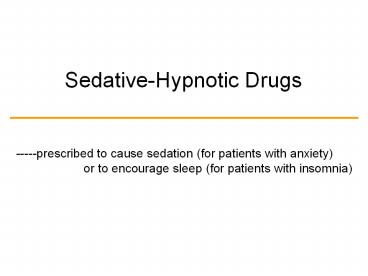Sedative-Hypnotic Drugs - PowerPoint PPT Presentation
1 / 22
Title:
Sedative-Hypnotic Drugs
Description:
Sedative-Hypnotic Drugs-----prescribed to cause sedation (for patients with anxiety) or to encourage sleep (for patients with insomnia) * * Buspirong: 5-HT receptor ... – PowerPoint PPT presentation
Number of Views:980
Avg rating:3.0/5.0
Title: Sedative-Hypnotic Drugs
1
Sedative-Hypnotic Drugs
-----prescribed to cause sedation (for patients
with anxiety) or to encourage
sleep (for patients with insomnia)
2
(No Transcript)
3
Chemical classification
- Benzodiazepines diazepam (??), nitrazepam (???),
oxazepam (????), estazolam (????), triazolam
(???), flunitrazepam (????),etc (with same
nucleus and different substituents) - Barbiturates pentobarbital(????), phenobarbital
(????), thiopental (???), etc - Others buspirone (????), chloral hydrate (????),
meprobamate (????), etc - Antipsychotic, antidepressant drugs and certain
antihistaminic agents
4
A. Benzodiazepines
- 1. ADME
- Oral absorption
- Lipid solubility-dependent distribution (across
BBB), placental penetrability (effect on fetus) - Hepatic metabolism ---active metabolites
- Urinary excretion
5
A. Benzodiazepines
1. ADME (5) Classification according to action
duration Short-acting triazolam,
laorazepam, oxazepam, etc Medium and
long-acting diazepam, nitrazepam,
chlordiazepoxide, flurazepam etc
6
Disassociation of effect and half-life time
7
A. Benzodiazepines
2. Pharmacological effects and clinical uses (1)
Reduction of anxiety at small doses, used as
anxiolytics (not work on schizophrenia) (2)
Sedative-hypnotic effects -- at relatively
higher doses -- no anesthetic effect --
no enzyme induction -- no remarkable effect
on REM, decrease slow wave sleep -- used for
insomnia and preanesthetic medication (as
adjuvant to anesthetics)
8
A. Benzodiazepines
(3) Antiepileptic and anticonvulsant effects
epilepsy, status epilepticus (i.v.),
convulsion (4) Centrally acting muscle relaxant
effect -- relaxing the spasticity of
skeletal muscle, probably by increasing
presynaptic inhibition in the spinal cord.
-- used for the treatment of skeletal muscle
spasms caused by central or peripheral diseases.
9
A. Benzodiazepines
(5) Others --dose-dependent anterograde
amnesic effects ( i.v.) - for
unpleasant examination or therapy (cardioversion,
endoscope, etc) --respiratory and CVS
effects (central inhibition) -- alleviate
the withdraw syndromes
10
Benzodiazepines
Graded dose-dependent depressive effect of
sedative- hypnotics on central nervous system
function
11
A. Benzodiazepines
3. Mechanisms of actions (1) Sites of action
mainly acts on limbic system (anxielytic) and
midbrain reticular formation (hypnotic). (2)
Interaction with GABAA receptor
-----increase the frequency of GABA-induced
channel-opening events ----- GABA
dependent efficacy
12
(No Transcript)
13
A. Benzodiazepines
4. Adverse effects (1) Central depression
Most common drowsiness and confusion
ataxia cognitive impairment (hangover effect)
Antagonized by BZ receptor antagonist
flumazenil Additive with other CNS
depressant drugs (2) Tolerance lethal dose is
not altered (3) Dependence compulsive misuse
Withdrawal syndrome (shorter acting agents)
restlessness, anxiety, weakness, orthostatic
hypotension and generalized seizures
14
A. Benzodiazepines
(3) Others Respiratory and CVS reactions
Teratogenic effects (Pregnancy Category D or
X) (4) Contraindications Myasthenia gravis
(?????) Infants lt 6 months Pregnant and lactation
mothers Elderly with heart/lung/liver/kidney
dysfunction Workers requiring mental alertness
and fine motor coordination
15
B. Barbiturates
1. ADME - hepatic enzyme inducer -
alkalizing urine (sodium bicarbonate) excretion
? 2. Pharmacological effects and clinical uses
(1) Sedative-hypnotic effects - REM decrease
(2) Antiepileptic and anticonvulsant effects
(3) Preanesthetic medication
16
- increase the duration of the GABA-gated
- chloride ion channel openings
- GABA-mimetic at high dose GABA independent
efficacy
17
B. Barbiturates
3. Adverse effects (1) Central depression after
(hangover) effect (2) Tolerance and dependence
long-term uses, REM rebound (3) Porphyria
(enhances porphyrin synthesis) anemia,
photosensitive skin injury (4) Acute poisoning
---supporting therapies oxygen inhalation,
unblocked respiratory tract (tracheotomy),
central stimulants ---alkalizing urine
---hemodialysis
18
Marilyn Monroe (1926-1962)
19
Barbiturates
Benzodiazepines
Graded dose-dependent depressive effect of
sedative- hypnotics on central nervous system
function
20
C. Other sedative-hypnotic drugs
- Chloral hydrate
- Sedative-hypnotic effects
- Anticonvulsant effect children (anal
administration) - Meprobamate sedative, hypnotive, anxiolytic
- Buspirone anxiolytic, minimal abuse liability
21
C. Other sedative-hypnotic drugs
- Antipsychotics
- Antidepressant drugs
- Antihistaminic agents
- Ethanol
- Melatonin (pineal hormone)
22
Summary of clinical uses of sedative-hypnotics

